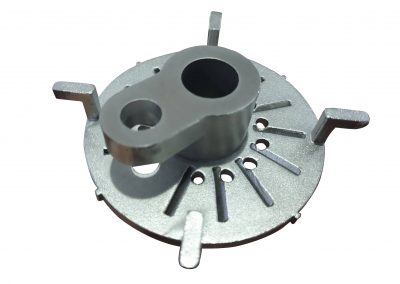Description
In investment casting, the process of pouring cast steel is a very important step. The most commonly used pouring method in investment casting is gravity pouring. First, the molten steel is poured from the furnace into the casting ladle and then poured into the shell that is already preheated. Then the molten steel cools off quickly and oxidizes, this method is the easiest to operated and the most commonly used casting method in investment casting foundries. Below is the important Points in the process of pouring cast steel :
Shell Pre-Heating
After a long period of time, the de-waxed shell is dried naturally in the air and needs to be heated again at a high temperature before pouring the liquid metal. If using silica sol casting shells, the casting need to be heated up during firing and kept in a furnace at a temperature of about 950°C for about 1 to 2 hours. For water glass casting shells, it needs to be heated at a furnace temperature for about 400 °C – 600 °C put into the furnace, and then heated up to 800 °C – 850°C holding for about 1 – 2 hours.
Purpose of Shell Pre-Heating
- Remove the moisture, salt, and residual mold material in the shell
- Avoid gas generation during the pouring, which is due to casting defects such as porosity and insufficient pouring in the casting
- To improve the strength and porous of the shell
- The shell must reach the proper temperature, so the molten metal will not cool down quickly when pouring.
Shell Temperature
Investment casting is hot casting, so the shell must be heated up first to a certain temperature before the casting process. So the temperature of the shell must be high rather than low. Should if the temperature of the shell is too low, the steel casting are prone to be defects such as cold barrier, inclusions, and pores. But if the temperature of the shell is too high, the crystal grains of the steel castings will be coarse, then the mechanical properties of the steel casting will also decrease.
In general, the temperature of the shell during the pouring process should be determined according to the structural characteristics of the steel casting. Suggested shell temperature for small castings with a wall thickness of less than 5 mm should be greater than 700 °C. For medium-sized castings with a wall thickness of 5mm to 10mm, the shell temperature is 600 °C – 700 °C, for large castings with a wall thickness of more than 10mm, the shell temperature must be less than 500 °C.
Pouring Temperature of Cast Steel
Pouring temperature is really important because if the temperature of the molten steel is too low, then the casting is difficult to form, and defects such as failure to pour, cold barrier, and casting inclusions are more like to occur. If the temperature of the molten steel during the pouring is too high, then it’s good for the formation of steel castings, but the crystal grains of the casting are coarse, shrinkage and deformation are likely to occur, and the tendency of decarburization increases. The pouring temperature of heavy-duty cast steel must be 50 ℃ – 80 ℃
Pouring Speed
Pouring speed also plays an important part in casting. If the casting speed of the steel castings is too fast, then it is Conducive to the forming of the steel castings, but bubbles and impurities more likely to appear. When pouring thicker castings or using the bottom pouring system, the pouring speed can be adjusted to fast and then slow to reduce the shrinkage of the casting. For thin-walled small parts, the pouring speed can be slow first then fast to reduce defects such as inclusions and pores
Why Should You Choose Zenith?
- Engineering, With 20 years of experience in Lostwax Casting, we are experts in casting any kind of products and materials. Updating knowledge is a must as part of our Engineering team’s daily workload.
- Quality Focus, Our focus is Zero defects at the customer site.With ISO 9001:2015, ISO 13485:2016, CE Marking and PED 2014/68/EU Annex. I,4.3 & AD 2000-W0 certified, we have a system to control every production step to get the required quality that customer needs,
- High Capacity, Our capacity a month can cover 120 tons with available induction furnaces range from 100kg, 150kg, and 250 kg.We also have 1 dedicated line for medical products (zenmed+)
- IT Utilize System, With every process is managed using a cloud system, the information flow is very quick and accessible everywhere & anytime.We also enable Extranet for customers to check their PO progress and related information and documents.
- Lean Manufacturing, By applying Lean Manufacturing, every process steps is Visual Controlled and Every Waste is identified and controlled using Continuous Improvement/Kaizen.
- Health, Safety, & CRS, By having certified for ISO 45001:2018 and ISO 14001:2015, We are committed to concern with our People Health, Safety & Environment. We are also a permanent donator for Indonesia Cancer Foundation and supporting Orphans nearby the Factory.












